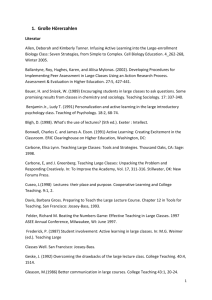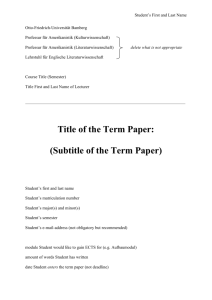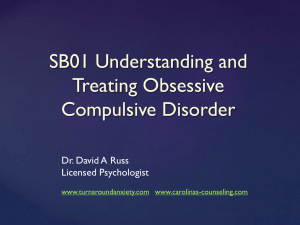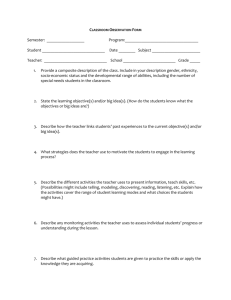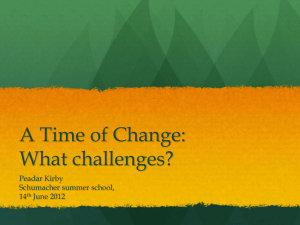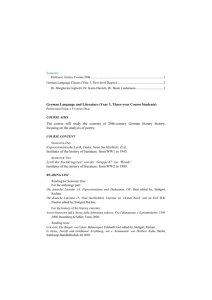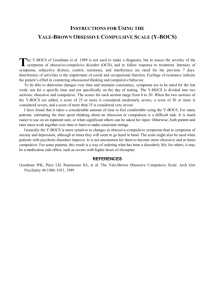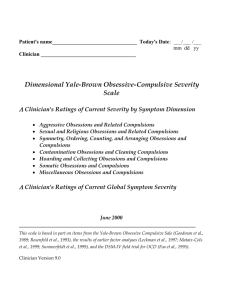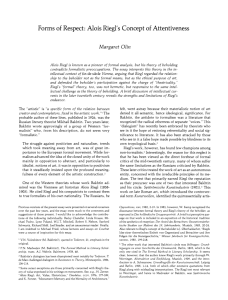Necessities/constraints(
advertisement
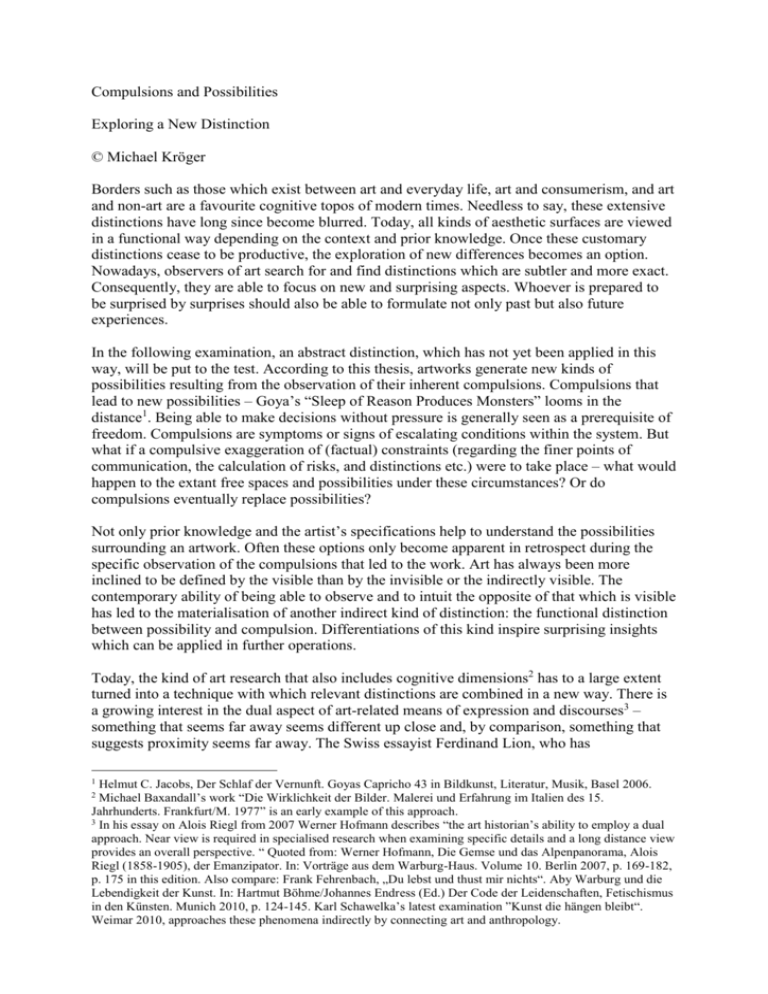
Compulsions and Possibilities Exploring a New Distinction © Michael Kröger Borders such as those which exist between art and everyday life, art and consumerism, and art and non-art are a favourite cognitive topos of modern times. Needless to say, these extensive distinctions have long since become blurred. Today, all kinds of aesthetic surfaces are viewed in a functional way depending on the context and prior knowledge. Once these customary distinctions cease to be productive, the exploration of new differences becomes an option. Nowadays, observers of art search for and find distinctions which are subtler and more exact. Consequently, they are able to focus on new and surprising aspects. Whoever is prepared to be surprised by surprises should also be able to formulate not only past but also future experiences. In the following examination, an abstract distinction, which has not yet been applied in this way, will be put to the test. According to this thesis, artworks generate new kinds of possibilities resulting from the observation of their inherent compulsions. Compulsions that lead to new possibilities – Goya’s “Sleep of Reason Produces Monsters” looms in the distance1. Being able to make decisions without pressure is generally seen as a prerequisite of freedom. Compulsions are symptoms or signs of escalating conditions within the system. But what if a compulsive exaggeration of (factual) constraints (regarding the finer points of communication, the calculation of risks, and distinctions etc.) were to take place – what would happen to the extant free spaces and possibilities under these circumstances? Or do compulsions eventually replace possibilities? Not only prior knowledge and the artist’s specifications help to understand the possibilities surrounding an artwork. Often these options only become apparent in retrospect during the specific observation of the compulsions that led to the work. Art has always been more inclined to be defined by the visible than by the invisible or the indirectly visible. The contemporary ability of being able to observe and to intuit the opposite of that which is visible has led to the materialisation of another indirect kind of distinction: the functional distinction between possibility and compulsion. Differentiations of this kind inspire surprising insights which can be applied in further operations. Today, the kind of art research that also includes cognitive dimensions2 has to a large extent turned into a technique with which relevant distinctions are combined in a new way. There is a growing interest in the dual aspect of art-related means of expression and discourses3 – something that seems far away seems different up close and, by comparison, something that suggests proximity seems far away. The Swiss essayist Ferdinand Lion, who has 1 Helmut C. Jacobs, Der Schlaf der Vernunft. Goyas Capricho 43 in Bildkunst, Literatur, Musik, Basel 2006. Michael Baxandall’s work “Die Wirklichkeit der Bilder. Malerei und Erfahrung im Italien des 15. Jahrhunderts. Frankfurt/M. 1977” is an early example of this approach. 3 In his essay on Alois Riegl from 2007 Werner Hofmann describes “the art historian’s ability to employ a dual approach. Near view is required in specialised research when examining specific details and a long distance view provides an overall perspective. “ Quoted from: Werner Hofmann, Die Gemse und das Alpenpanorama, Alois Riegl (1858-1905), der Emanzipator. In: Vorträge aus dem Warburg-Haus. Volume 10. Berlin 2007, p. 169-182, p. 175 in this edition. Also compare: Frank Fehrenbach, „Du lebst und thust mir nichts“. Aby Warburg und die Lebendigkeit der Kunst. In: Hartmut Böhme/Johannes Endress (Ed.) Der Code der Leidenschaften, Fetischismus in den Künsten. Munich 2010, p. 124-145. Karl Schawelka’s latest examination ”Kunst die hängen bleibt“. Weimar 2010, approaches these phenomena indirectly by connecting art and anthropology. 2 unfortunately been forgotten but deserves to be rediscovered, described “an accumulation of different but simultaneous events ” in his essay “Alt- und Neuschöpfung im Kunstwerk (old and new creations in artworks)”4 which was published in 1938. Many apparently secure parameters become shaky when artists define aspects beyond their artworks as the basis of these works.5 Observers of these kinds of artworks constantly arrive at new ideas: they are obliged to acknowledge the novelty of these possibilities and compulsions which suddenly arise before they can actually apply them. The advantage of this distinction is that complexity, which is also used by artists, is dealt with temporally. Both sides of the distinction are media that differ from one another with regard to their relationship to different futures. To some extent, this aspect reduces the fixation on the work’s presence, in other words, the direct effect of the work’s immediacy. Niklas Luhmann once said that in a system which depends on reality the question is whether and how to risk an orientation according to possibilities6. The medium art shows how the medium possibility could function as a means of orientation – namely by also taking the other aspect of the distinction, in other words, the compulsions resulting from this predicament, into consideration. Possibilities are not yet realised options which can be used in order to observe different versions of the present – compulsions, on the other hand, are special “arrangements” which can be used in order to deal with imminent futures and disorders. The combinability of these two aspects leads to new, so far unexplored forms of an approach – this applies especially to works of contemporary art. To distinguish between possibilities and compulsions, is to give this special differentiation an adequate form. Today, one of the possibilities provided by artworks is the formulation and combination of new defining criteria; however, the resulting compulsion to immediately apply these criteria is no indication of the significance of this operation. After recombining certain aspects, the results are observed. The implications of this approach become clear when observing the medium art and specifically when describing the new problems that develop due to the correlation of opposites. In this respect, art functions both in a chronological and in a factual way, in other words, it is paradoxical: on the one hand, the increasing amount of options enables the continuation of a certain work while on the other hand the growing number of constraints undermines this process. At the same time, substituting other activities for compulsions becomes not only conceivable but also possible. Replacement itself can be used as a medium of differentiation. Because it no longer functions as a work, an artwork must develop through the articulation of its own manifestation and the subtle expression of its functionality. A work which is created in this way separates the formal production process from the observation of its own distinctions. The functionality of art not only generates its own kind of expression but also a non-functioning empty space, in other words, a fiction which shows what would be possible and in which way it would be possible if art were to disappear suddenly – and a life were to 4 Ferdinand Lion, Geist und Politik in Europa. Verstreute Schriften aus den Jahren 1915-1961. Ed. Fritz Martini and Peter de Mendelsohn. Heidelberg, 1980, p. 249. 5 Compare: Hans Belting, Der Blick hinter Duchamp’s Tür. Kunst und Perspektive bei Duchamp. Sugimoto. Jeff Wall. Cologne 2009. 6 Niklas Luhmann, Die Wissenschaft der Gesellschaft, Ffm 1992, p. 686. develop in a medium no longer called art. However, what could or should this medium be called? If art could also be that which it cannot yet be today, it would evolve outside itself. Nonetheless, this process would still occur in a language capable of describing its functionality. When the creation of an artwork occurs somewhere beyond its own boundaries, the historical context of art can be replaced by something else, that is to say, by something contemporary. Today, art does not necessarily have to connect with existing art -- it has become a medium of its own ability to communicate. However, the way in which this happens is likely to reveal previously unknown possibilities. Even though art probably no longer operates under the label art, it is still obliged to create a certain effect of novelty. Today, one of the purposes of art is to extend the historical concept. This also includes novelties. Consequently, new can be defined as that which makes another form of the differentiation seem compulsory. Art develops on the basis of the distinction between that which is still possible and that which is already mandatory. Nothing is impossible in the medium of art unless it is given a shape. Today every possibility seems to incorporate the compulsion to expect the reversal of current reality itself – and then to replace this distinction with another, more subtle form.


